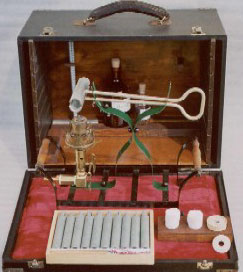
The Permanent Wave:
A German Invention Turns 100
TWIG - On October 8, 1906, the German hairdresser Karl Nessler unveiled a technology that changed the shape of hair, literally, for a century to come. After years of experimentation, including two attempts that completely incinerated his wife Katharina’s hair, Nessler had finally perfected a chemical treatment to add permanent curls to straight hair.
Born in 1872 in the small town of Todtnau in the Black Forest, Nessler began his life long study of human hair with an apprenticeship at a barber shop after finishing school. While working and studying at swanky salons in Geneva and Paris, he began experimenting with using strong alkalis and heat to curl hair. The process was dangerous and unreliable at first, but Nessler and his courageous test subjects persevered until the process was commercially viable.
The patent Nessler finally received in 1909 described a process by which hair was wrapped tightly around a metal rod, treated with sodium hydroxide, and then heated for ten minutes with specially machined cylindrical tongs that had been held over a gas flame.

Nessler's original gas-fired home perm kit
Although the client still risked burns and hair loss for her curls, Nessler had found a process reliable enough that vanity could trump danger. By 1911, enough women were willing to pay for the expensive process that the inventor, who had changed is name to the French-sounding Charles Nestle, could build a "House of the Permanent Wave" in London, where he and his wife had settled. Nestle’s invention became so popular that he even made house calls to rich women in Paris who wanted to receive a perm by the inventor’s own hand.
When World War I broke out, British authorities confiscated his business and interned him as an enemy alien. Nestle managed to escape from the internment camp and in 1915 he arrived in New York under the guise of a Mister Miller. In New York, thousands of imitators were already selling permanent waves using his process, but Nestle was able to capitalize on the poor quality offered by these perm pirates and soon had a successful salon on E. 49th Street.
By 1927, he employed nearly 500 people and sold tens of thousands of home perm machines annually. In 1928, he sold his businesses and patents for 1.5 million dollars. Before he eventually lost much of his fortune in the 1929 stock market crash, he sent thousands of dollars and 34 tons of donated clothes to Todtnau to alleviate the poverty caused by the rampant inflation and unemployment that hit Germany in the early 1920’s.
Although the Nestle process was replaced with other
techniques that use less caustic chemicals and lower temperatures, his core
vision - that no one needs to settle for straight hair as long as they are
willing to put in the time and money - has endured decades of changing
trends and no small amount of scorn. Today, men and women can choose between
the tightly curled manes that German soccer stars sported in the 1970’s,
loose natural waves, and perms that relax over time.
Republished with permission from "The Week in Germany"
